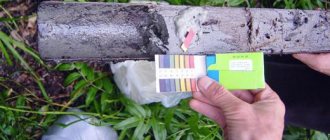Soil for azaleas: composition
The substrate for azaleas must be specific in composition, since its main task is to support the life of symbiont microorganisms living in the roots of the plant.
Microorganisms help the plant extract all the necessary microelements from the soil. If you manage to destroy the symbionts, the azalea will soon dry up too. For good growth and abundant flowering, the plant requires an acidic environment, with a pH reaction from 3.5 to 5.5.
The recommended soil composition should include:
- Peat
- river sand
- Coniferous land
- Perlite
- Mineral supplements
- Vermicompost
Attention! Indoor rhododendron is picky about soil, so you should not buy soil intended for growing other, unpretentious plants.
However, the composition for azaleas is suitable for growing other flowers that love an acidic environment.
Gerberas, philodendrons, heathers, cranberries, and pelargoniums feel great in soil for azaleas.
We invite you to watch a video about what soil should be like for an azalea:
Features of the soil needed for indoor and outdoor rhododendron
Ordinary soil used for planting other plants is most likely not suitable for azaleas, since the roots of rhododendron contain important fungal symbiont microorganisms (read about the role of roots in the life of azaleas and about the rooting of a flower here).
With their help, the plant receives the nutrients necessary for life from the soil; if they die, the plant loses its viability. The existence of these microorganisms is due to a highly acidic environment.
Which is better: buy soil for azaleas or prepare it yourself
For a novice gardener, it is recommended to plant azaleas in a ready-made substrate, although it grows equally well in both store-bought and home-made ones.
You can find various ready-made soil mixtures on sale, which differ in manufacturer, product quality and price.
It is important to know! When purchasing soil, you need to pay attention to the label and look at the release date. If the soil mixture has been on sale for a long time, it means that it has already lost most of its beneficial substances.
How to choose a composition for a houseplant?
The composition of the soil for Azaleas must include the following components:
- Leaf soil. It is light and loose and allows air and water to pass through well. This soil has average nutritional value and is obtained by rotting tree leaves. Leafy soil enhances acid reactions. It is obtained as follows. At home, in the fall, fallen leaves are collected and this pile is left for one or two years to rot. Then used to grow indoor plants and to increase soil acidity.
- Coniferous soil is loose soil with an acidic reaction. The pH of coniferous soil is 4–5. What kind of soil is taken under coniferous trees, but not from above, but from below. The needles in the soil should be well rotted. Coniferous soil is light and airy.
- Peat soil is also light and loose. Such soil must be included in the soil. Its acidity is 3.5–5.5. Such soil perfectly provides the mineral balance of the soil mixture. Peat soil is obtained from high-moor peat, the decomposition period of which is at least a year. Perfectly improves the overall composition of the soil, giving it nutritional value and looseness.
- Heather soil has a high content of organic matter and high acidity. However, it is poor in phosphorus, potassium and nitrogen. In its properties it is very close to leaf and peat soils. It is obtained in places where heather and other similar plants grow. The leaves and stems of heather rot and form a fertile layer. How correctly is such a layer no more than 3 centimeters. Such soil has high air and water permeability, as well as high heat capacity.
- River sand , as a rule, is used in floriculture as an additive to the soil mixture. Sand does not accumulate moisture and does not increase the moisture capacity of the soil. Water remains only on the surface of the grain of sand. Only clean sifted river sand is suitable for growing azaleas. Before adding it to the mixture, it must be processed: washed and baked in the oven for disinfection.
How to make soil for azaleas with your own hands
To prepare the composition on your own, you will have to look for the necessary components and mix them in the required proportions.
Special soil for azaleas should include the main components: peat, leaf, heather and sand. A mandatory component is coniferous soil.
Pine bark is used as a necessary component. It acts as an additional oxidizing agent.
To improve moisture and breathability, it is recommended to add river sand, agroperlite and vermiculite.
You need to disinfect the soil with sphagnum moss or you can add charcoal. It is advisable to use only one component. Azalea does not like waterlogged soil, so it is recommended to place a drainage layer 3 cm high at the bottom of the pot.
Preparation of the composition with your own hands, proportions:
- Heather soil
- Coniferous land
- Sand
- High peat
- Leaf ground
- Lowland peat
The ratio of components is as follows: 1:2:1:1:2:1.
The structure of the soil should be loose, light, air- and moisture-permeable, but retain moisture. To keep water in the soil longer, it is recommended to add hydrogel in granules.
The modern method is an alternative to drip irrigation. After watering, the hydrogel swells, absorbs excess moisture, and then gradually releases it to the plant.
Many gardeners advise adding sawdust, conifer needles, leaf humus, and pine bark to the soil. These components maintain the acidity level in the soil.
Home azalea description, photo
Azalea is a dwarf plant called "rosewood". A special feature of the culture is its lush flowering in winter. In the Alps, these wonderful flowers are called “roses”, because in appearance the bud strongly resembles a true rose. This variety belongs to the extensive and popular genus – Rhododendron. The indoor flower comes from Japan and China. However, in the wild, bushes can be found in Southern Europe and North America. Translated from Greek, “rhodon” means “rose”, and “dendron” means “tree”. That is why the name “rose tree” is quite justified.
After discovering a wild species in the mountains, scientists began to work on selecting and breeding various varietal species. The result of many years of work has become more than 10 thousand varieties and species. Many cultures have a special place for azaleas. In Europe, for example, the flower is the main decoration of the Christmas table and is a symbol of family happiness and prosperity. Depending on the varietal species, the height of the bush can reach 1.5 m. An indoor flower usually does not exceed a height of 60 cm.
The stems may become partially woody, and the side shoots branch beautifully on both sides. The foliage is rich green in color and has a semi-oval shape. The buds are considered the main value of the plant. They gather in a complex inflorescence and form far in the leaf axils. The color of the inflorescence can be varied. The most common are scarlet, snow-white and cream buds. After purchasing or replanting, a home bush can continue flowering throughout the season.
The rose tree appeared on the territory of Russia at the beginning of the twentieth century, and was grown exclusively in botanical gardens. In nature there are about 350 varieties of flowers. Indian and Japanese azaleas have gained popularity in home cultivation. These varieties are evergreen shrubs, not exceeding 50 cm in height. Japanese azalea can be grown in the garden.
Interesting! Winter flowering is why azalea gained its popularity and love from gardeners. Depending on the variety, flowering can last from November to March and from December to April.
Recommendations for planting
To enjoy the lush and abundant flowering of azaleas, it is important to follow some recommendations:
- Indoor rhododendron prefers bright but diffused light. The foliage should not be exposed to direct sunlight. It is preferable to grow on windowsills on the north or west side.
- Content temperature. It is important to note that at any time of the year the room should be cool. Buds are formed at a temperature within +16-18°C, so this regime is considered optimal.
- Watering. Regular watering with soft, settled water is required. You can’t water with warm water, cool is better. When the earthen ball dries out, it is recommended to lower the pot with the plant into a container of water to moisten the soil.
- Air humidity. The moisture-loving plant needs daily spraying of the foliage. But! During flowering, azaleas should not be sprayed.
Young specimens are replanted every year (more likely it will be a transshipment), an adult plant needs to be replanted no more often than once every 3 years. When transplanting or transshipping a plant, you need to be careful with the root system, as it is very delicate and fragile. If you damage the roots, you can destroy the flower.
When replanting, it is important to monitor the root collar, which must be left on the surface of the soil.
Note! The period of flower bud formation occurs in October-November, so it is necessary to organize additional lighting.
Let's watch a useful video about planting azaleas:
Possible problems and ways to solve them
Falling leaves (not to be confused with deciduous azalea!), lack of flowering, wilting are signals that the soil is not selected correctly. The reasons may be excess peat content, lack of acidity or heaviness of the earth. The only way to solve these problems is transplantation. In case of lack of acidity, it must be increased.
Attention! Over time, the soil may settle. In this case, it must be replenished and mulched.
It must be remembered that soil is an important component for the life of an azalea. If the soil is chosen correctly, the plant will grow, bloom and lift your spirits with its beauty, so it is better to carefully select it. With proper care and good conditions, the azalea will no longer be a disposable plant.
Mistakes that are usually made when preparing soil and how to correct them
Many gardeners make a lot of mistakes when preparing soil at home.
Too heavy soil. In such soil, the plant simply cannot survive, since the root system will not be able to absorb microelements and vitamins. If it is noticed that the azalea is not growing, replanting it into loose, breathable soil is required.
The soil is slightly acidic. At a low pH level, the life of symbiont microorganisms is impossible, and thanks to them the plant receives all the necessary nutrients.
There is only one way out: add pine bark, coniferous needles, and leaf humus to the soil as quickly as possible.
High peat content. An excess of low-lying peat will result in a heavy, moisture-intensive soil structure. If water stagnates in the soil, the root system will rot. It is recommended to transfer the plant to good soil.
If the soil is chosen correctly, then there is no doubt that the plant will smell fragrant and delight you with flowering. Indeed, in suitable soil, the necessary metabolic processes will take place in the plant itself, and the azalea will have enough nutrition and moisture. If the soil is not selected correctly, the azalea will not grow.
Which soil does a flower like and which does it not?
In order for an azalea to feel comfortable, the soil must have moisture and water permeability, be light and fairly loose, contain the necessary acidity, a large amount of humus and nutrients, and also retain moisture well.
Neutral soil is absolutely not suitable for planting; this is justified by the fact that the acids and alkalis contained in it are completely balanced and lead to neutralization of each other. It is highly not recommended to use crushed limestone as drainage, as it alkalizes the soil, making it less acidic.
Reference. Do not add ash to the soil or use fertilizers containing chlorine and lime.
How can you acidify soil for azaleas?
As mentioned above, an acidic environment is required by microorganisms that support vital processes occurring in the plant. An alkaline environment is detrimental to both symbionts and azaleas.
The composition should contain coniferous soil, as it is a natural acidifier. When purchasing a mixture for azaleas, it is important to pay attention to this component.
You can increase acidity by adding pine bark to the substrate. Before use, it must be washed, dried and crushed. Only after this can the bark be mixed into the soil.
If it is not possible to purchase pine bark, it is recommended to go to the store and ask a specialist to select a special acidifier that is used to increase the acidity of the soil. Use only in accordance with the instructions.
To ensure that the flower does not lose its attractiveness after purchase, it is necessary to replant the azalea in properly prepared soil, since good soil is the key to the long life of indoor rhododendron.
Is the land suitable?
From rhododendron to other plants
Azalea soil is perfect for less demanding plants that prefer soil with high acidity.
It is suitable for plants such as:
- blueberry;
- sedge;
- gerbera;
- heather plants;
- philodendron;
- cranberry;
- hydrangea;
- geranium;
- Platyceriums.
From other plants to the flower itself
The main difficulty in growing azaleas is its “capriciousness” - this is what does not allow, in the vast majority of cases, the use of soil from other plants for planting it.
Features of transplanting azaleas in the garden
Transplantation or planting of a street representative in the garden is carried out in early spring, before active sap flow. As a last resort, transplanting the species can be postponed to the beginning of autumn. Street azalea has shallow roots, which is why it does not require a deep hole for planting. Depth - no more than 50 cm, width - 70-80 cm. The bottom of the seat is covered with a thick layer of broken brick or gravel.
On a note! When lime chips are added to the soil, the acidity of the soil gradually changes. This is harmful to azaleas.
The soil should consist of nutritious soil, peat, humus and river sand. The landing of a street representative is no different from an indoor one. The root collar of the transplanted plant should be located above ground level. After planting, the soil is compacted and moistened.
Planting and propagation
Azaleas are propagated mainly by cuttings. Pay attention to the fact that the cuttings are older than six months. The cuttings are cut after the flowering period, then they are planted in soil intended for azaleas. The top of the container with cuttings is covered with film. Plantings are watered regularly. Rooting of the shoots occurs in approximately 1.5 months, and then they are placed in separate containers.
There must be holes at the bottom, and drainage (expanded clay) at the bottom of the pot. Transplantation is carried out when flowering ends. Transplantation is carried out carefully so as not to damage the thin roots of the crop. Young azaleas are replanted once a year, and adults - once every 3 or 4 years.
Pruning and crown formation
An important role in caring for azaleas at home is played by pruning and pinching. Pinching is a mandatory technique for azaleas, as this helps to increase the intensity of flowering. You can prune an azalea only after flowering, removing overgrown and weak shoots. To form the crown, young shoots are pinched, and shoots formed near the flower buds must be removed. New leaves on the cut shoots will appear only after 2-3 weeks. If you do not form the crown of an azalea, then over time it will become more and more spreading, with a decrease in the number of flower buds.
As a houseplant, azalea is formed in two ways - in the form of a compact shrub or a miniature tree.
- In the form of a tree. Choose the strongest and straightest growing branch. Only this is left - the rest are cut off at the root. The branch is tied to a support and the pot is turned regularly. When the desired height is reached, the top is pinched. Young side shoots are regularly pinched, forming a spherical shape. Early flowering varieties are pruned in March-April, late flowering varieties - in May-June. The purpose of spring pruning is to shorten last year's shoots and remove weak branches.
- In the form of a bush. The cuttings are cut at a height of 10-12 cm from the soil surface. Side branches are also regularly pinched at the same level. For uniform growth, the bush is periodically turned with the other side towards the light.
Fertilizer and feeding
Mineral fertilizers are suitable for feeding azaleas; the main thing is to ensure that the composition does not contain chlorine, which can kill the plant. To minimize difficulties and problems, it is recommended to use Azalea fertilizer purchased from a specialized store. You can also use fertilizers for decorative flowers, for example “Lux” or “Fertika”.
In the spring-summer period, fertilizers should be applied once a week, and in the fall and winter, reduce the amount of fertilizing to once a month.
When the period of bud formation and flowering begins, phosphorus-potassium fertilizers, for example “Kemira-Lux” or “Uniflor-bud”, must be used to feed the azalea.
For additional nutrition of the plant, you can use superphosphate by diluting 15 grams of the product in 1 liter of water.
How to resuscitate
In general, Azaleas are very capricious not only to the conditions surrounding them. If a flower begins to die, it is almost impossible to save it. Even if we correct ourselves and recreate the ideal microclimate, it will most likely be too late.
In case of sudden wilting, we can only advise saving some of the most surviving shoots by transplanting, for example, to another place. And after that, understand the cause of the problem and try not to repeat it.
And new shoots will grow quickly. With proper care, you can achieve the first flowers as early as next year.
Diseases and pests
Leaf of an azalea affected by pests
Azaleas often experience leaf loss. The reasons may be either improper watering (both insufficient and excessive), or exposure of the leaves to the sun (then burns occur, and then the greenery dries out).
Among insects, Azalea is favored by spider mites and moths. You can combat them by treating them with soapy water or Bordeaux mixture.
Useful video:
Azalea is a whimsical flower
Almost everyone who sees an Azalea for the first time is overcome by the desire to purchase it, but you need to know that indoor Azalea is a capricious flower and demanding to care for, and it is especially troublesome to make this beauty bloom.
Azaleas have delicate flowers, bright colors, and wonderful shapes. Unlike species that grow in the wild and have a strong, intoxicating odor, Azaleas bred for indoor cultivation have no odor or have a very weak aroma. It is for the sake of beautiful flowers that everyone strives to grow indoor Azalea, and if you also decide to have this beauty in your apartment, get ready for serious trials.
The workers of the greenhouse where I first saw her told me something about caring for indoor Azalea, and I learned something from specialized literature and the Internet. And then I gained my own experience.
Transfer
Replanting a domestic azalea
It is important to replant an azalea immediately after purchase. But only if it has not yet bloomed.
One of the conditions for replanting is to take a pot at least 5 centimeters larger than the previous one each time. Experienced gardeners also recommend maintaining certain time intervals:
- For young plants, replant every year, approximately in the spring, but most importantly, not during the flowering period and not in winter.
- Adult plants are replanted less frequently - once every 2-3 years.
Each time you should carefully inspect the bush and do not be afraid to remove dried or fading shoots, leaves, and roots from it. On the contrary, it is even welcome.
Soil for plants
Natalya February 24, 2021 Category: Houseplants
The expression: “To Caesar the things that are Caesar’s, and to the scribe the things that are scribes” suits the choice of soil for plants like no other. Indeed, each flower needs its own special soil. Of course, there are group characteristics, that is, plants can be combined according to growing conditions, and therefore according to soil requirements. This allows you to select a mixture not for one particular flower, but for a group. Otherwise, transplanting and planting flowers would turn into a titanic work - try to choose an individual mixture for each flower, verified like in a pharmacy.
Further flower care
During the period of active growth, the plant is watered promptly and abundantly. Moistening is carried out as the top layer of soil dries. Warm, settled water is suitable for irrigation.
Additional Information! Adding citric acid to water for irrigation will help maintain the required level of soil acidity.
In dry times, the bush requires spraying, which is carried out early in the morning or after sunset. By the end of the season, watering is reduced by at least half. Due to lack of moisture, the azalea stops growing and can survive the winter without any problems. Flower feeding is carried out three times a year:
- Nitrogen fertilizers are applied immediately after the flower “awakens” - in early spring.
- At the time of budding, potassium and phosphorus are added to the soil.
- After the buds fade, the soil is fertilized with a mixture of phosphorus and potassium. Composition proportion 1:2.
Important! Do not allow liquid to get on the root collar. Water the plant at a distance of at least 10-20 cm from the center of the azalea.
Indoor and outdoor azaleas are a responsive crop. Compliance with the norms and rules of agricultural technology will invariably lead to abundant flowering. The view can easily become a decoration not only for any home, but also for a personal plot.











